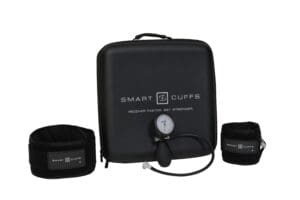

Blood Flow Restriction (BFR) is an approach that can be used during outpatient physical therapy to promote muscle strengthening safely and effectively. A properly trained Physical Therapist can use BFR during physical therapy to help patients significantly increase muscle strength while working out with very low weights.
Why Use Blood Flow Restriction In Physical Therapy?
Elite and professional athletes have used blood flow restriction training for years to help build strength to perform at their maximum potential. The benefits of BFR for physical therapy patients are similar to those of healthy athletes training for competition - safe and effective strengthening of muscles so you can regain function, maximize performance, and return to the active lifestyle you deserve. Often, physical therapy patients are restricted from using heavier weights to avoid straining injured or post-operative tissues. BFR training uses very light weights that are safe for physical therapy patients AND provides the strengthening benefits of lifting heavier, more strenuous weights. The outcome? Increased strengthening and a potentially quicker recovery in a safe physical therapy setting.
How Does Blood Flow Restriction Work?
FDA-approved devices are applied to a patient's injured extremity (arm or leg). Similar to a tourniquet, the device acts as a cuff and is inflated to a specific pressure. Arterial blood still flows to the muscle, but venous return is reduced by 50 - 80%. While the blood flow is restricted, patients perform strengthening exercises using very light weights. Even though the weights used are very light, the blood flow restriction during the rehabilitation exercises creates a muscle "burn", increased muscle size, and accelerated strengthening - similar to what happens when a healthy athlete lifts heavy weights but without the strain and risk of using heavier weights.
The Benefits of Blood Flow Restriction During Physical Therapy
The use of BFR has been shown to:
- Reduce recovery time / allow patients to return to activity quicker
- Safely and significantly increase muscle strength through the use of light weights
- Reduce pain allowing earlier restoration of normal movement patterns
- Improve aerobic performance
- Potentially improve bone healing
Is Blood Flow Restriction Safe?
BFR devices are FDA-approved. The risks associated with BFR are similar to the general risks associated with exercise.
To learn more about Blood Flow Restriction or to schedule an appointment, please call one of our BFR-trained locations below.
